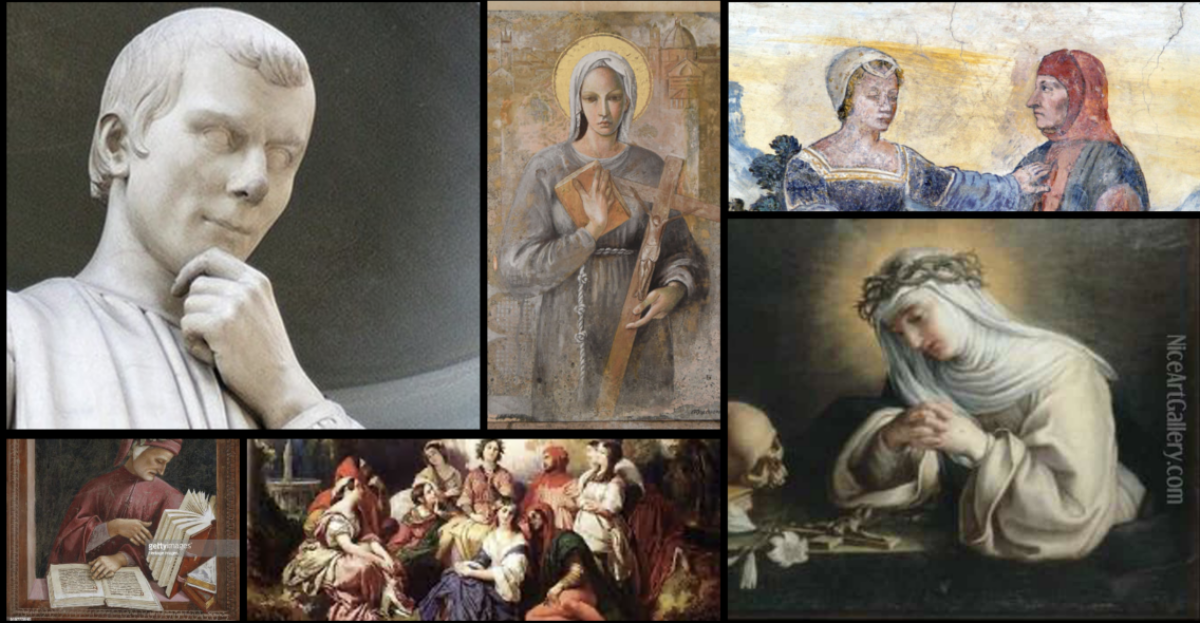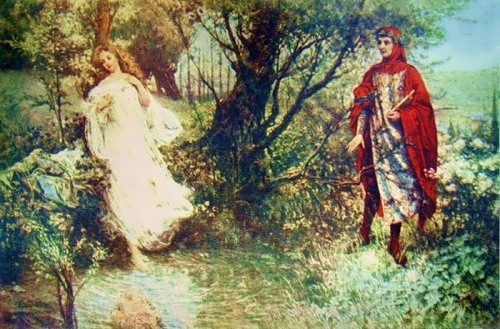Throughout The Divine Comedy by Dante and Il Canzoniere by Petrarca, women and love are portrayed in very similar ways that intrigued me. During this course, I loved reading these particular texts because these authors’ portrayals of love and women were very enlightening and movie-like. They portrayed women as very delicate goddesses, which is my most preferable way to read about women. Growing up, I loved to read fairy tales about princesses falling in love and happily ever after. In these texts by Dante and Petrarca, they brought me back to my younger reading days, and they stuck with me a lot more because of that.
In The Divine Comedy, Dante writes and vividly describes his journey through hell in search to finally reach heaven. In Inferno, the poem about hell, he describes his path through the different circles of hell. He is guided by a Roman poet by the name of Virgil, who was sent to him by his love, Beatrice. Each circle represents a different sin. There was a circle for gluttony, wrath, heretics, and many more. However, before Dante entered the gates of Hell, he was unsure if he should do it or not. It was his love and devotion to see Beatrice that motivated him to take on his journey. Beatrice wanted him to take on this journey, so she along with two other women sent for Virgil. For instance, in Canto 2 of the Inferno, Beatrice states, “O Mantuan Shade, in courtesy complete, whose fame survives on earth, nor less shall grow through all the ages, while the world hath seat; a friend of mine, with fortune for his foe, has met with hindrance on his desert way, and, terror-smitten, can no further go, but turns; and that he is too far astray, and that I rose too late for help, I dread, from what in heaven concerning him they say. Go, with thy speech persuasive him bestead, and with all needful help his guardian prove, That touching him I may be comforted. Know, it is Beatrice seeks thee thus to move. Thence come I where I to return am fain: my coming and my plea are ruled by love. When I shall stand before my Lord again, often to him I will renew thy praise.” This pledge from Beatrice shows how much she truly loves Dante and wants him to get guidance while he goes through hell. She said that she is coming to him out of love for Dante, which was very pure hearted. Dante then states, “When of these words she spoken had the last, she turned aside bright eyes which tears did fill, and I by this was urged to greater haste. And so it was I joined thee by her will. As flowers, by chills nocturnal made to pine and shut themselves, when touched by morning bright upon their stems arise, full-blown and fine; so of my faltering courage changed the plight, and such good cheer ran through my heart, it spurred me to declare, like free-born generous wight: alert in service, hearkening her true word! Thou with thine eloquence my heart has won to keen desire to go, and the intent which first I held I now no longer shun. Therefore proceed; thou art my guide, Lord, Master; thou alone!’ Thus I; and with him, as he forward went, the steep and rugged road I entered on.” Dante’s response was very heartwarming and sweet to read because he knew that it was destined for him to go on this trip because Beatrice wanted him to and because he knew that he had the chance to see her in the end. His love for her as well and Virgil and God made him determined to start and continue his journey. In addition, in Canto 5, Dante enters the Second Circle of Hell, which is for the sin of lust. Dante met a woman named Francesca da Rimini who he felt very sorry for because she gave into lust and desire. He mentioned how him and Beatrice’s love is chaste, which was virtuous and eventually led him closer to God. This was very significant to me because it proved how serious and deep Dante and Beatrice’s connection was, and it contrasted from the sinful love that Francesca gave into.
In continuation, Il Canzionere by Petrarca also had a very evocative depiction of love and women. In this story, the main theme is the many love poems/letters that Petrarca wrote for his love, Laura. In my opinion, his love for Laura was the strongest out of all the texts we have read. He had a very profound passion for Laura and it was very obvious while reading the poems. I was very intrigued and drawn into the poems about Laura because it radiates divine feminine energy. For example, in poem 90 of Il Canzoniere, Petrarca states, “She’d let her gold hair flow free in the breeze that whirled it into thousands of sweet knots, and lovely light would burn beyond all measure in those fair eyes whose light is dinner now. Her face would turn the color pity wears, a pity true or false I do not know, and I with all love’s tinder in my breast; it’s no surprise I quickly caught on fire. The way she walked was not the way of mortals but of angelic forms, and when she spoke more than an earthly voice it was that sang: a godly spirit and a living sun was what I saw, and if she is not now, my wound still bleeds though the bow’s unbent.” This poem is very crucial to the theme of love and it is a very vivid description of the way that Petrarca feels about Laura. When he talks about her eyes and her angelic forms, it makes women seem so delicate and fragile which I really enjoyed reading from a male perspective. During this course, I came to realize that from my experience, the way love was depicted in ancient literature was way deeper and more passionate than the way it is depicted in stories now. This was one of the reasons why I enjoyed continuing to read the texts in this course. All the elements and aspects are much more intense and even though at times it was hard to follow on, the passion from the authors always came through, and especially Petrarca. The Editors of the Encyclopedia Britannica did a summary on Il Canzoniere and made Laura a literary subject in their analysis. The Encyclopedia Britannica states, “The poems treat a variety of moods and subjects but particularly his intense psychological reactions to his beloved. Many of his similes, such as burning like fire and freezing like ice, beautifully stated in the sonnet beginning ‘I find no peace, and all my war is done,’ were to be frequently repeated by sonneteers of Elizabethan England and later became poetic cliches. Some of the poems express the very simple, human wish to be with her and to be treated kindly. After Laura’s death Petrarch’s poems continued on the same themes, expressing his sorrow and describing her to return to him in dreams.” This quote from The Encyclopedia is very important because it explains how captivating Petrarca’s tactics were in the poems he was writing about Laura. The quote even says that his similes were later on used by different poets and eventually his quotes became cliche because of how often they were being used.
To conclude, The Divine Comedy by Dante and Il Canzoniere by Petrarca portray love and women in very similar and fascinating ways. Both authors have very strong characters and passion for the women they are idolizing and it made their texts way more intriguing to read and analyze. Their portrayal of love was like a fantasy in a fairytale, and the way they depicted women brought out their use of great vocabulary and literary tactics in their writing, which made those connections feel stronger.
References:
- Britannica, The Editors of Encyclopaedia. “Laura”. Encyclopedia Britannica, 2 Apr. 2021, https://www.britannica.com/biography/Laura-literary-subject. Accessed 21 December 2021.
- Petrarca, Francesco, and Mark Musa. Selections from the Canzoniere (Poem 90) Oxford [Oxfordshire: Oxford University Press, 1999. Print.
- Dante, Alighieri, and Mark Musa. Dante’s Inferno. Canto ll; Bloomington: Indiana University Press, 1971.




Thank you, Alanis! I will email you my comments.